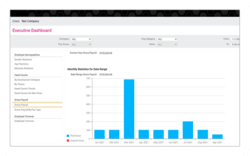Mental Health In The Workplace: A Guide To Helping Your Employees
Over 70% of workers say that the pandemic has been the most stressful time of their career, leading to feeling hopeless, burned out, or exhausted. And that’s brought mental health in the workplace to the forefront of conversation. But while many businesses know that workers are struggling, they often don’t know what to do to help. Since productivity, morale, and retention are at stake, it’s critical to address the mental health needs of your employees today.
At Complete Payroll Solutions, our certified HR professionals assist thousands of companies with workforce concerns, like the impact of COVID-19 on workers. We know this is a particularly difficult time for employers and employees alike, and also understand the steps you can take to appropriately respond to the situation. To help you learn approaches to support your workers today, here we’ll discuss:
- What is mental health in the workplace
- Can I ask a worker if they have mental health issues
- What is the impact of mental health in the workplace
- How can I help with mental health in the workplace
After reading this article, you’ll know what to do to help employees cope right now to protect their health and well-being, and the future of your company.
What is mental health in the workplace?
While many of the signs and symptoms of mental health issues may not be apparent at work, there are several that may manifest in the workplace. According to the International Foundation of Employee Benefit Plans, these include:
- Increased emotionality, such as tears from someone who normally does not tend to cry
- Social withdrawal or conflict with others
- Increased missed appointments
- Appears tired or slow
- Looks confused at times and has a hard time making decisions
- Making more mistakes or lagging behind
- Increased conversations about problems
- Signs of alcohol or drug abuse
When employees are experiencing these effects, it can create problems in your business, which we’ll discuss next.
What is the impact of mental health in the workplace?
When employees are suffering from mental health issues, that can have a significant impact on your business. There are several effects you may witness:
- Decreased employee performance: Mental health problems affect workers’ functional working capacity. Patients with depression suffer 11.5 days of reduced productivity.
- Higher rates of illness: Common effects of mental health issues include cardiovascular disease, high blood pressure, headache, neck and back ache.
- More absenteeism: In the US, an estimated 200 million days are lost from work each year due to depression.
- An increased number of accidents: Work-related stress is a major cause of human error, which can lead to accidents.
- Greater staff turnover: Due to a lack of motivation and commitment, or in some cases, burnout, you risk employees leaving.
Can I ask a worker if they have mental health issues?
If you notice any of the signs or symptoms of mental illness, you shouldn’t ask if the employee is suffering from anxiety or depression. In fact, you can’t require an employee to disclose a mental health condition unless the employee is asking for a reasonable accommodation under the ADA or you’re engaging in affirmative action for people with disabilities, and in a few other circumstances.
If an employee voluntarily tells you that they have a mental health issue, which is considered a disability, they are protected under ADA and you can’t discriminate against them. That means you can’t fire them, reject them for a job or promotion, or force them to take leave. Likewise, if an employee doesn’t disclose to you that they have a disability that is protected under ADA, you should not assume that they do or the same protections will be in place.
Either way, the key is to determine how your organization can best support mental health in the workplace and employees who are struggling as quickly as possible.
How can I help with mental health in the workplace?
According to the CDC, the workplace is an optimal setting to support employees’ mental health, where you can take several steps to help, including:
- Make mental health self-assessment tools available to all employees and offer free or subsidized clinical screenings for depression.
- If you offer health insurance, offer plans with no or low out-of-pocket costs for depression medications and mental health counseling.
- Distribute materials to employees about the signs and symptoms of poor mental health and opportunities for treatment so they know the resources available to them. Creating a sense of awareness also makes employees feel accepted, and that what they are feeling is okay.
- Host seminars or workshops that address depression and stress management techniques, which will also help employees know it’s okay to share.
- Create and maintain dedicated, quiet spaces for relaxation activities or offer online access to relaxation classes.
- Provide managers with training to help them recognize the signs and symptoms of stress and depression in team members as well as how to communicate, refer employees to appropriate resources, and highlight employee programs available like EAP, health benefits, or on-site counseling services.
All of these steps can help to normalize mental health issues and show that you care about the mental health of employees, which can help you be in a better position to attract and retain workers. In fact, 60 percent said mental health benefits will factor into selection of their next job.
How to Best Support Mental Health in the Workplace
Even before COVID-19, nearly 1 in 5 Americans struggled with mental illness. And that means you likely have employees who are suffering from the disease. Taking steps to support the well-being of your workforce is essential today to preserve the health of your employees and your company.
Complete Payroll Solutions’ certified HR professionals can help you prioritize mental health in the workplace. Our team offers outsourced HR support that can be a good fit for you if you want:
- Best practices on employee communication
- A partner who can help you create the right benefits, from EAPs to health insurance
- Strategies for increased flexibility in the workplace to foster a better work-life balance
- Live or e-learning trainings for managers and/or employees
With morale suffering, now is the time to act to enhance your standing as an employer of choice. Read our next article on the great resignation trend that’s sweeping the country and how embracing what matters most to employees can help set you apart.
in
 HR
,
Mental Health
,
Employee Engagement
HR
,
Mental Health
,
Employee Engagement



